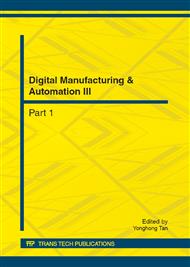[1]
Z. Shen. Dynamic interactions analysis of HJ-1B satellite platform and onboard infrared camera scanning mirror, Master Dissertation of National University of Defense Technology, 2005, pp.21-33.
Google Scholar
[2]
Z. F. Yu, Z. C. Yang, Effects of Scan Mirror Motion on the Attitude of Three-Axis-Stabilized Geostationary Satellite, Journal of Northwestern Polytechnical University. 2003, Vol. 21, pp.87-90.
Google Scholar
[3]
J. T. Zhao, G. Li, Y. Yang, High Fidelity Simulation Model for High Torque Capability Compensating Mechanism, Aerospace Control and Application, 2011, Vol.37, pp.26-32.
Google Scholar
[4]
J. Yu, Y. Liao, W. Liu, Torque Compensation Technology for High-Accuracy Remote Satellite. Aerospace Shanghai, 2011, pp.12-17,60.
Google Scholar
[5]
B. Armatrong-Helouvry,P. Dapont,and C. Canudas, A survey of models,analysis tools and compensation methods for the control machines with friction, Automatica, 1994, Vol. 30, pp.1083-1183.
DOI: 10.1016/0005-1098(94)90209-7
Google Scholar
[6]
M. Sean, T. David, Bearing health monitoring and life extension in satellite momentum/reaction wheels. Proceedings of the IEEE Aerospace Conference, 2006, Vol. 3, pp.4-11.
DOI: 10.1109/aero.2006.1656138
Google Scholar
[7]
M, Flouros, The impact of oil and sealing air flow, chamber pressure, rotor speed, and axial load on the power consumption in an aeroengine bearing chamber, Journal of Engineering for Gas Turbines and Power, 2005, Vol. 27, pp.183-186.
DOI: 10.1115/1.1805009
Google Scholar
[8]
G. C. Goodwin, S. F. Graebe, M. E. Salgado. Control system design. New Jersey: Prentice-Hall, 2001.
Google Scholar
[9]
H. Cheng, S. M. Ge, F. C. Liu, et al. The design of torque mode control for reaction wheel system. Journal of Astronautics, 2006, Vol. 27, pp.1248-1253.
Google Scholar


